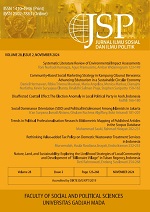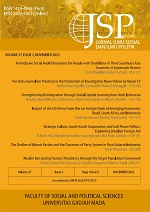The Return of Media Diplomacy: Examples from Kosovo
Hasan Saliu(1), Gazmend Abrashi(2*)
(1) Faculty of Mass Communication, AAB College, Pristina, Kosovo
(2) Faculty of Mass Communication, AAB College, Pristina, Kosovo
(*) Corresponding Author
Abstract
After the Cold War, states focused their campaigns on self‐promotion on the global stage, so media diplomacy has been pushed to the periphery, hence not being a central research theme. However, the geopolitical clashes over Kosovo and the war in Ukraine have repositioned the role of media diplomacy in international politics. This paper aims to analyze Kosovo's media diplomacy in the following key moments: at the time of the declaration of independence (2008), and during the Russian aggression in Ukraine (2022). Data were collected from global media such as CNN, Al Jazeera, Reuters, and The New York Times, which have given space to Kosovo’s political actors and influential global politicians. The US president Bush was the example of the enormous media coverage in 2008. Messages of these communications were analyzed using the framing method. The results show that media diplomacy revived in three cases: before and after Kosovo's declaration of independence in 2008, and again in 2022, with the fear that the Russian scenario for Ukraine would be followed by Serbia against Kosovo. Also, media diplomacy today establishes communications between countries with no diplomatic relations and even between countries with strained relationships.
Keywords
Full Text:
PDFReferences
Ammon, R. (2001). Global television and the shaping of world politics: CNN, telediplomacy, and foreign policy. McFarland.
Belli, C. S. (2003). Teorie delle relazioni internazionali [The Theory of International Relations]. Guerra Edizioni Gurru.
Bjola, C., Cassidy, J., & Manor, I. (2019). Public diplomacy in the digital age. The Hague Journal of Diplomacy, 14(1–2), 83–101. https:// doi.org/10.1163/1871191X‐14011032
Boorstin, D. J. (1992). The Image: A guide to Pseudo-events in America. Vintage Books Edition.
Bush calls for independent Kosovo. (2007, June 11). Al Jazeera. Retrieved from https:// www.aljazeera.com/news/2007/6S/11/bush-calls-for-independent-kosovo-3
Bush Gets Rock Star Welcome in Albania. (2007, June 10). ABC News. Retrived from https://abcnews.go.com/WNT/ story?id=3264690&page=1
Bush insists Kosovo must be independent and receives hero’s welcome in Albania. (2007, June 11). The Guardian. Retrieved from https://www.theguardian.com/ world/2007/jun/11/balkans.usa
Bush makes landmark visit to Albania. (2007, June 10). The Telegraph. Retrieved from https://www.telegraph.co.uk/news/worldnews/1554129/Bush‐makes‐landmark-visit-to-Albania.html
Bush: U.N. must act now on Kosovo. (2007, June 10). CNN. Retrieved from http:// edition.cnn.com/2007/POLITICS/06/10/ bush.europe/
Bytyci, F. (2017, January 16). Serbia wants to annex part of Kosovo using “Crimea model”: President. Reuters. Retrieved from https://www.reuters.com/article/us‐serbia‐kosovo‐president‐idUSKBN15022Y
Cassidy, J., & Manor, I. (2016). Crafting strategic MFA communication policies during times of political crisis: A note to MFA policy makers. Global Affairs, 2, 331-343.
Castells, M. (2008). The New Public Sphere: Global Civil Society, Communication Networks, and Global Governance. Annals of the American Academy of Political and Social Science, 616(1), 78–93. https://doi.org/10.1177/0002716207311877
Castells, M. (2015). Networks of outrage and hope social movements in the internet age. Polity Press.
Cohen, Y. (1986). Media Diplomacy. Frank Cass. Crilley, R., Manor, I., & Bjola, C. (2020). Visual narratives of global politics in the digital age: An introduction. Cambridge Review of International Affairs, 33(5), 628–637. https://doi.org/10.1080/09557571.2020.1813465
Crilley, R., Manor, I., & Bjola, C. (2020). Visual narratives of global politics in the digital age: An introduction. Cambridge Review of International Affairs, 33(5), 628–637. https://doi.org/10.1080/09557571.2020.1813465
Cull, N. J. (2006, April 18). Public Diplomacy Before Gullion: The Evolution of a Phrase. USC Center on Public Diplomacy. Retrieved from http://uscpublicdiplomacy.org/ blog/060418_public_diplomacy_before_ gullion_the_evolution_of_a_phrase
Cull, N. J. (2008). Public Diplomacy: Taxonomies and Histories. The Annals of the American Academy of Political and Social Science, 616(1), 31–54. https://doi.org/10.1177/0002716207311952
Dayan, D., & Katz. (1992). Media Events: The Live Broadcasting of History. Harvard University Press.
De Vresse, C. (2005). News framing: Theory and typology. Information Design Journal, 13(1), 51–62.
Di Martino, L. (2019). Conceptualising public diplomacy listening on social media. Place Branding and Public Diplomacy, 16, 131–142. https://doi.org/10.1057/s41254‐019-00135-5
Entman, R. M. (1993). Framing: Toward clarification on a fractured paradigm. Journal of Communication, 43(4), 51–58.
Fisher, M. (2022, February 24). Putin’s Case for War, Annotated. The New York Times. https://www.nytimes.com/2022/02/24/ world/europe/putin‐ukraine‐speech.html
Fjällhed, A. (2021). Managing Disinformation through Public Diplomacy. Public Diplomacy and the Politics of Uncertainty. Palgrave Macmilan.
Floridi, L. (2014). The 4th Revolution. How the Infosphere Is Reshaping Human Reality. Oxford University Press.
Frederick, H. H. (1992). Global Communication and International Relations. Wadsworth.
Gilboa, E. (1998). Media diplomacy: Conceptual divergence and applications. Harvard International Journal of Press/Politics, 3(3), 56–75.
Gilboa, E. (2001). Diplomacy in the media age: Three models of uses and effects. Diplomacy and Statecraft, 12(2), 1–28. https://doi.org/10.1080/09592290108406201
Gilboa, E. (2005). Media-Broker Diplomacy: When Journalists Become Mediators. Critical Studies in Media Communication, 22(2), 99–120. https://doi.org/10.1080/07393180500071998
Gilboa, E. (2016). Digital Diplomacy. In C. Constantinou, P. Kerr, & P. Sharp (Eds.), The SAGE Handbook of Diplomacy (pp. 540–661). Sage Publication.
Gilboa, E. (2008a). Media diplomacy. In W. Donsbach (Ed.), The international encyclopaedia of communication (pp. 2852–2858). Blackwell Publishing Ltd.
Gilboa, E. (2008b). Searching for a Theory of Public Diplomacy. The ANNALS of the American Academy of Political and Social Science, 616, 55–77. https://doi.org/10.1177/0002716207312142
Golan, G. J. (2015). An Integrated Approach to Public Diplomacy. In G. J. Golan, S. U. Yang, & D. F. Kinsey (Eds.), International Public Relations and Public Diplomacy: Communication and Engagement (pp. 37–50). Peter Lang.
Golan, G. J., Manor, I., & Arceneaux, P. (2019). Mediated Public Diplomacy Redefined: Foreign Stakeholder Engagement via Paid, Earned, Shared, and Owned Media. American Behavioral Scientist, 63(2), 1665–1683. https://doi.org/10.1177/0002764219835279
Gregory, B. (2011). American Public Diplomacy: Enduring Characteristics, Elusiv e Transformation. The Hague Journal of Diplomacy, 6, 3–4.
Hehir, A. (2019). Introduction: Kosovo’s Symbolic Importance. Journal of Intervention and State Building, 13(5), 539–544. https://doi.org/10.1080/17502977.2019.1663986
Jönsson, C. (2016). Diplomacy, Communication and Signalling. In C. M. Constantinou, P. Kerr, & P. Sharp (Eds.), The SAGE Handbook of Diplomacy (pp. 79–91). Sage Publications Ltd.
Kosovo PM: “Serbia is on the side of the Russian Federation.” (2022, April 4). CNN. Retrieved from https://edition.cnn.com/ videos/tv/2022/04/04/exp‐tgb‐kosovo‐prime-minister-albin-kurti-ukraine-russia-serbia.cnn
Kosovo president accuses Russia of destabilising Balkans. (2022, April 17). Reuters. Retrieved from https://www.reuters.com/world/europe/kosovo‐president‐accuses‐russia‐destabilising‐balkans‐2022‐02‐17/
Kosovo President: We’ll pay any price to defend democracy. (2022, April 15). CNN. Retrieved from https://edition.cnn.com/ videos/tv/2022/04/15/amanpour‐ukraine‐ kosovo-balkans-vjosa-osmani.cnn
Kruzel, J. (2008). Bush Voices Support for Kosovo Independence. U.S. Department of Défense. Retrieved from https://archive.defense.gov/news/newsarticle.aspx?id=48996
Kunczik, M. (1997). Images of Nations and International Public Relations. Lawrence Erlbaum As sociates-Publis hers Mahwah.
Laurano, P. (2006). Fondamenti di comunicazione politica internazionale [Fundamentals of international political communication]. Bonanno Editore.
Leonard, M. (2002). Public Diplomacy. The Foreign Policy Centre.
Lim, Y. J. (2017). Concept ual models of media diplomacy: For the resolution of international communication conflict. Outlook on Communication, 7(1), 11–21.
Malone, G. (1985). Managing Public Diplomacy. The Washington Quarterly, 8. Manor, I. (2019). The digitalization of public diplomacy. Palgrave Macmillan.
Manor, I. (2019). The digitalization of public diplomacy. Palgrave Macmillan.
Manor, I., & Crilley, R. (2018). Visually framing the Gaza War of 2014: The Israel ministry of foreign affairs on Twitter. Media, War & Conflict, 11, 369–391.
Masmoudi, M. (1981). The new World information order and direct broadcasting satellites. Syracuse Journal of International Law and Commerce, 8. Retrieved from https://surface.syr.edu/cgi/viewcontent. cgi?article=1125&context=jilc
Middleton, R. (2017, January 16). Kosovo accuses Serbia of planning to seize slice of state. International Business Times. Retrieved from https://www.ibtimes. co.uk/kosovo‐accuses‐serbia‐planning‐ seize-slice-state-1601375
Newman, N., Fletcher, R., Kalogeropoulos, A., & Nielsen, R. K. (2019). Reuters Institute. Digital News Report 2019. University of Oxford. Retrieved from https://reutersinstitute.politics.ox.ac.uk/ sites/default/files/2019‐06/DNR_2019_ FINAL_0.pdf
Newman, N., Fletcher, R., Robertson, C. T., Eddy, K., & Nielsen, R. K. (2022). Reuters Institute. Digital News Report 2022. University of Oxford. Retrieved from https://reutersinstitute.politics.ox.ac.uk/sites/default/files/2022‐06/Digital_News-Report_2022.pdf
Nye, J. Jr. (2004). Soft Power: The Means to Success in World Politics. Public Affairs.
Nye, J. Jr. (2008). Public Diplomacy and Soft Power. The ANNALS of the American Academy of Political and Social Science, 616 (1), 94–109. https://doi.org/10.1177/0002716207311699
Nye, J. Jr. (2019). Soft Power and Public Diplomacy Revisited. The Hague Journal of Diplomacy, 14, 7–20. https://doi.org/10.1163/1871191X‐14101013
Pacher, A. (2018). Strategic Publics in Public Diplomacy: A Typology and a Heuristic Device for Multiple Publics. The Hague Journal of Diplomacy, 13(3), 272–296. https://doi.org/10.1163/1871191X‐13020004
Peres, R., Talwar, S., Alter, L., Elhanan, M., & Friedmann, Y. (2020). Narrowband Influencers and Global Icons: Universality and Media Compatibility in the Communication Patterns of Political Leaders Worldwide. Journal of International Marketing, 28 (1), 48–65. https://doi.org/10.1177/1069031X19897893
Potter, E. (2002). Cyber-Diplomacy: Managing Foreign Policy in the Twenty-First Century. Montreal and Kingston: McGill-Queen’s Univ ersity Press. McGill ‐ Queen’s University Press.
Ramaprasad,J.(1983).Mediadiplomacy:Insearch of a definition. Gazette, 31, 69–78. https://doi.org/10.1177/001654928303100107
Rawnsley, G. D. (1995). Media diplomacy: Monitored broadcasting and foreign policy. Discussion Papers in Diplomacy, Centre for the Study of Diplomacy, University of Leicester.
Saliu, H. (2013). The image of a country, communication actors in educational exchanges. Thesis, 2(1), 89–98.
Saliu, H. (2018). Multiple Target Audiences, Critical Analysis of Pristina-Belgrade Dialogue. On-Line Journal Modelling the New Europe, 26, 108–123. https://doi. org/10.24193/OJMNE.2018.26.08
Saliu, H. (2021). The specifics and complexity of EU public diplomacy. Druzboslovne Razprave/Social Science Forum, XXXVII(96–97), 189–207.
Saliu, H. (2020b). Public Diplomacy and Related Concepts from the Perspective of Lasswell’s Communication Formula. Jahr–European Journal of Bioethics, 11(2), 357–376. https://doi.org/10.21860/j.11.2.2
Saliu, H. (2022b). Public Diplomacy or Public Glocalization? Rethinking Public Diplomacy in the post-Truth Era. Vestnik Moskovsko go Universiteta. Seriya 10. Zhurnalistika, 1, 157–175. https://doi.org/10.30547/vestnik.journ.1.2022.157175
Saliu, H. (2020a). The Evolution of the Concept of Public Diplomacy from the Perspective of Communication Stakeholders. Medijska Istraživanja, 26(1), 69–86. https://doi.org/10.22572/mi.26.1.4
Saliu, H., & Llunji, V. (2022a). Cultural Diplomacy of Kosovo after the Declaration of Independence. Information & Media, 93, 62–76. https://doi.org/10.15388/Im.2022.93.61
Scheufele, D. A. (1999). Framing as a theory of media effects. Journal of Communication, 49(1), 103–122. https://doi.org/10.1111/j.1460‐2466.1999.tb02784.x
Seib, P. (2012). Real-time diplomacy: Politics and power in the social media era. Palgrave MacMillan.
Semetko, H. A. (2009). Media and Public Diplomacy in Times of War and Crisis. American Behavioral Scientis, 52, 639–642. https://doi.org/10.1177/0002764208324602
Serbian outrage over Bush remarks. (2007, June 11). CNN. Retrieved from http://edition. cnn.com/2007/POLITICS/06/11/bush.europe/index.html
Shearer, E., & Eva Matsa, K. (2018). News Use Across Social Media Platforms 2018. Pew Research Center. Retrieved from https://www.pewresearch.org/journalism/2018/09/10/news‐use‐across‐ social‐media‐platforms‐2018/
Shinar, D. (2000). Media Diplomacy and ‘Peace Talk’. The Middle East and Northern Ireland. Gazette, 62(2), 83–97.
Snow, N. (2020). Exchanges as Good Propaganda. In N. Snow & N. J. Cull (Eds.), Routledge Handbook of Public Diplomacy (pp. 422–429). Routledge.
Szondi, G. (2008). Public Diplomacy and Nation Branding: Conceptual Similarities and Differences. Netherlands Institute of International Relations ‘Clingendael’.
Taylor, A. (2017, January 17). ‘It’s the Crimea model’: Kosovo accuses Serbia of seeking to annex province. The Washingt on Post. Retrieved from https://www.washingtonpost.com/news/worldviews/wp/2017/01/17/its‐the‐crimea‐model‐ kosovo-accuses-serbia-of-seeking-to-annex‐province/
Thaci: Rusia do ta njohe Kosoven. [Thaci: Russia will recognize Kosovo]. (2009, February 2). Top Channel. Retrieved from http://top‐channel.tv/2009/02/19/thaci‐ rusia‐do‐ta‐njohe‐kosoven/
Thousands Hail Bush in Visit to Albania. (2007, June 11). The New York Times. Retrieved from https://www.nytimes.com/2007/06/11/world/europe/11prexy.html
Tsfati, Y., Boomgaarden, H. G., Strömbäck, J., Vliegenthart, R., Damstra, A., & Lindgren, E. (2020). Causes and consequences of mainstream media dissemination of fake news literature review and synthesis. Annals of the International Communication Association, 44(2), 157‐173. https://doi.org/10.1080/23808985.2020.1759443
U.S. Embassy in Kosovo. (2017). Embassy Comment on Train to North Mitrovica. Retrieved from https://xk.usembassy. gov/train/
US Urges Serbia, Kosovo to Avoid Nationalist Rhetoric. (2017, January 17). VOA . Retrieved from https://www.voanews. com/a/united‐states‐urges‐kosovo‐serbia‐ avoid‐dangerous‐retoric/3680745.html
Yun, S. H. (2012). Relational public diplomacy: The perspective of sociological globalism. International Journal of Communication, 6(21), 2199–2219.
Zaharna, R. S. (2014). Network purpose, network design: Dimensions of network and collaborative public diplomacy. In R. S. Zaharna, A. Arsenault, & A. Fisher (Eds.), Relational, networked, and collaborative approaches to public diplomacy: The connective mind shift (pp. 173–191). Routledge.
Zakaria, T., & Tzortzi, E. (2007, June 10). Bush says Kosovo to be independent, delights Albania. Reuters. Retrieved from https://www.reuters.com/article/us‐bush‐albania-idUSTZO01747120070610
Article Metrics
Refbacks
- There are currently no refbacks.
Copyright (c) 2023 Jurnal Ilmu Sosial dan Ilmu Politik

This work is licensed under a Creative Commons Attribution-ShareAlike 4.0 International License.























